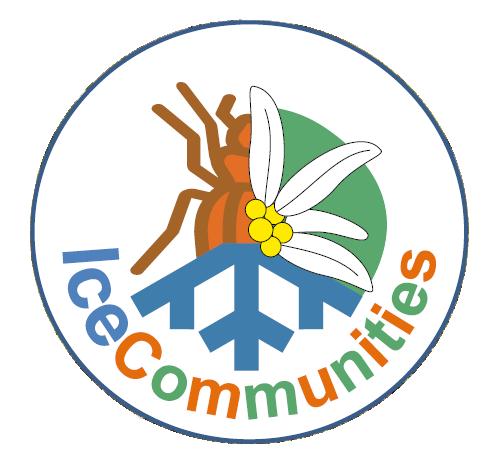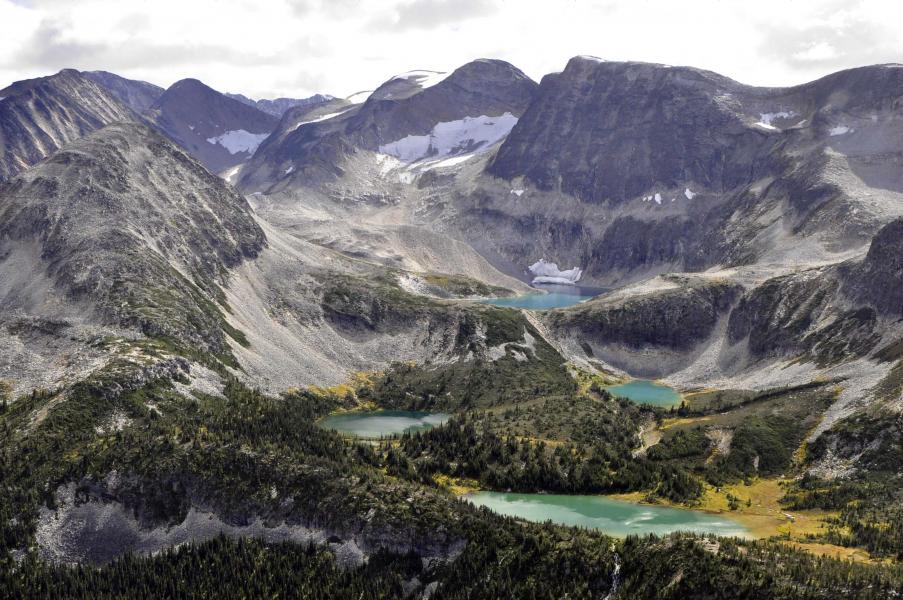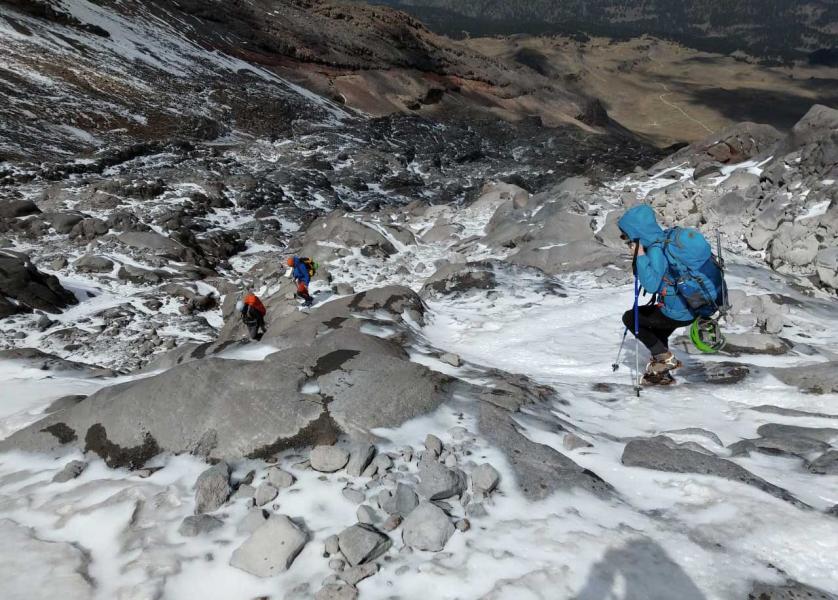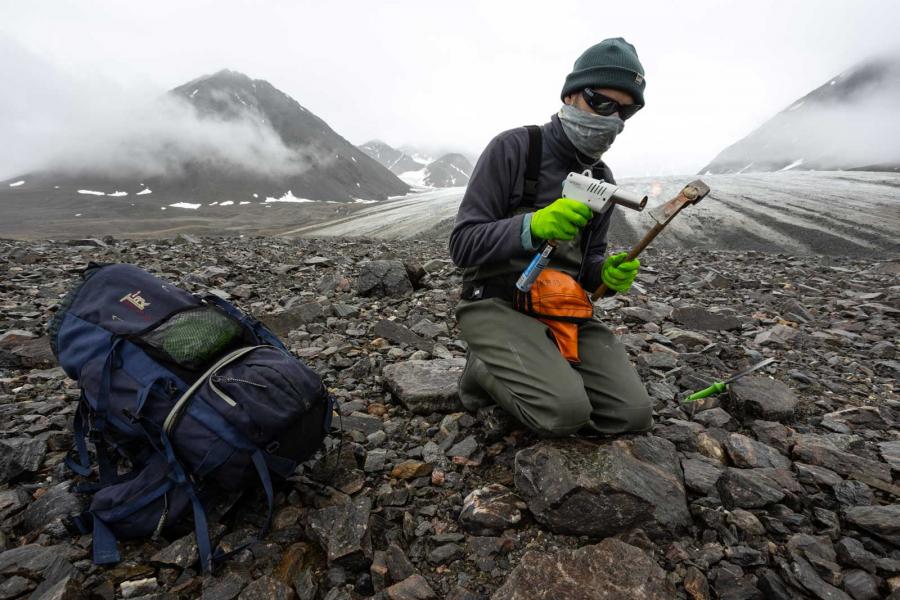IceCommunities

Glaciers are retreating all over the globe. Increasing areas are exposed and colonized by multiple organisms, but lack of global studies hampers a complete understanding of the future of recently deglaciated terrains. What will be the fate of these areas? How do animals, plants and microorganisms colonize them? How do they interact to perform successful colonization? Which are the processes determining colonization patterns? How does ecosystem functioning evolves through time? Until recently, the complete reconstruction of soil communities was hampered by the complexity of identification of organisms, thus analyses at broad geographical and taxonomic scale have been so far impossible. The IceCommunities project (2018-2024) combined innovative methods and a global approach to boost our understanding of the evolution of ecosystems in recently deglaciated areas. We investigated chronosequences ranging from recently deglaciated terrains to late successional stages of soil pedogenesis, exploiting the power of environmental DNA metabarcoding.
The IceCommunities project aimed at obtaining a complete reconstruction of biotic communities along glacier forelands over multiple mountain areas across the globe. This allowed measuring the rate of colonization at an unprecedented taxonomic detail and completeness. Information on assemblages was combined with analyses of soil, landscape and climate to identify the drivers of community changes. Furthermore, IceCommunities assesses the impact of eco-geographical factors (climate, regional pool of potential colonizers) on colonization.
Due to ongoing climate change, deglaciated areas are an increasingly important component of mountain and high-latitude ecosystems. Understanding the consequence of glacier retreat is thus a hot topic for both ecology and global change studies, with researchers trying to understand the consequence of retreat and to develop scenarios on how mountain environments may change over the next century. IceCommunities will help to predict the future development of these ecosystems, providing a supported rationale for their management.
LINK TO THE PROJECT WEBSITE
https://cordis.europa.eu/project/id/772284/it
RESULTS IN SHORT
https://cordis.europa.eu/article/id/451625-how-retreating-glaciers-spawn-new-ecosystems/it
OUTCOMES OF THE PROJECT



Partners

Publications
- Cantera, I., Carteron, A., Guerrieri, A., Marta, S., Bonin, A., Ambrosini, R., Anthelme, F., Azzoni, R. S., Almond, P., Alviz Gazitúa, P., Cauvy-Fraunié, S., Ceballos Lievano, J. L., Chand, P., Chand Sharma, M., Clague, J., Cochachín Rapre, J. A., Compostella, C., Cruz Encarnación, R., Dangles, O., … Ficetola, G. F. (2024). The importance of species addition ‘versus’ replacement varies over succession in plant communities after glacier retreat. Nature Plants, 10(2), 256–267. https://doi.org/10.1038/s41477-023-01609-4
- Carteron, A., Cantera, I., Guerrieri, A., Marta, S., Bonin, A., Ambrosini, R., Anthelme, F., Azzoni, R. S., Almond, P., Gazitúa, P. A., Cauvy-Fraunié, S., Lievano, J. L. C., Chand, P., Sharma, M. C., Clague, J., Rapre, J. A. C., Compostella, C., Encarnación, R. C., Dangles, O., … Ficetola, G. F. (2024). Dynamics and drivers of mycorrhizal fungi after glacier retreat. New Phytologist, 242(4), 1739–1752. https://doi.org/10.1111/nph.19682
- Ficetola, G. F., Guerrieri, A., Cantera, I., & Bonin, A. (2024). In silico assessment of 18S rDNA metabarcoding markers for the characterization of nematode communities. PLoS ONE, 19(4), e0298905. https://doi.org/10.1371/journal.pone.0298905
- Guerrieri, A., Cantera, I., Marta, S., Bonin, A., Carteron, A., Ambrosini, R., Caccianiga, M., Anthelme, F., Azzoni, R. S., Almond, P., Alvizgazitua, P., Cauvy-Fraunie, S., Ceballoslievano, J. L., Chand, P., Chandsharma, M., Clague, J., Cochachinrapre, J. A., Compostella, C., Cruzencarnacion, R., … Ficetola, G. F. (2024). Local climate modulates the development of soil nematode communities after glacier retreat. Global Change Biology, 30(1), e17057. https://doi.org/10.1111/gcb.17057
- Bonin, A., Guerrieri, A., & Ficetola, G. F. (2023). Optimal sequence similarity thresholds for clustering of molecular operational taxonomic units in DNA metabarcoding studies. Molecular Ecology Resources, 23(2), 368–381. https://doi.org/10.1111/1755-0998.13709
- Ficetola, G. F., & Taberlet, P. (2023). Towards exhaustive community ecology via DNA metabarcoding. Molecular Ecology, 32(23), 6320–6329. https://doi.org/10.1111/mec.16881
- Giachello, S., Cantera, I., Carteron, A., Marta, S., Cipriano, C., Guerrieri, A., Bonin, A., Thuiller, W., & Ficetola, G. F. (2023). Toward a common set of functional traits for soil protists. Soil Biology and Biochemistry, 187, 109207. https://doi.org/10.1016/j.soilbio.2023.109207
- Marta, S., Zimmer, A., Caccianiga, M., Gobbi, M., Ambrosini, R., Azzoni, R. S., Gili, F., Pittino, F., Thuiller, W., Provenzale, A., & Ficetola, G. F. (2023). Heterogeneous changes of soil microclimate in high mountains and glacier forelands. Nature Communications, 14, 5306. https://doi.org/10.1038/s41467-023-41063-6
- Zawierucha, K., Kasparova, E. S., Mcinnes, S., Buda, J., Ambrosini, R., Devetter, M., Ficetola, G. F., Franzetti, A., Takeuchi, N., Horna, P., Jaromerska, T. N., Ono, M., Sabacka, M., & Janko, K. (2023). Cryophilic Tardigrada have disjunct and bipolar distribution and establish long-term stable, low-density demes. Polar Biology, 46(10), 1011–1027. https://doi.org/10.1007/s00300-023-03170-4
- Guerrieri, A., Carteron, A., Bonin, A., Marta, S., Ambrosini, R., Caccianiga, M., Cantera, I., Compostella, C., Diolaiuti, G., Fontaneto, D., Gielly, L., Gili, F., Gobbi, M., Poulenard, J., Taberlet, P., Zerboni, A., Thuiller, W., & Ficetola, G. F. (2022). Metabarcoding data reveal vertical multitaxa variation in topsoil communities during the colonization of deglaciated forelands. Molecular Ecology, 32(23), 6304–6319. https://doi.org/10.1111/mec.16669
- Lunghi, E., Valle, B., Guerrieri, A., Bonin, A., Cianferoni, F., Manenti, R., & Ficetola, G. F. (2022). Environmental DNA of insects and springtails from caves reveals complex processes of eDNA transfer in soils. Science of The Total Environment, 826, 154022. https://doi.org/10.1016/j.scitotenv.2022.154022
- Rozwalak, P., Podkowa, P., Buda, J., Niedzielski, P., Kawecki, S., Ambrosini, R., Azzoni, R. S., Baccolo, G., Ceballos, J. L., Cook, J., Di Mauro, B., Ficetola, G. F., Franzetti, A., Ignatiuk, D., Klimaszyk, P., Lokas, E., Ono, M., Parnikoza, I., Pietryka, M., … Zawierucha, K. (2022). Cryoconite – From minerals and organic matter to bioengineered sediments on glacier’s surfaces. Science of The Total Environment, 807(Pt 2), 150874. https://doi.org/10.1016/j.scitotenv.2021.150874
- Arribas, P., Andujar, C., Bidartondo, M. I., Bohmann, K., Coissac, E., Creer, S., deWaard, J. R., Elbrecht, V., Ficetola, G. F., Goberna, M., Kennedy, S., Krehenwinkel, H., Leese, F., Novotny, V., Ronquist, F., Yu, D. W., Zinger, L., Creedy, T. J., Meramveliotakis, E., … Emerson, B. C. (2021). Connecting high-throughput biodiversity inventories: Opportunities for a site-based genomic framework for global integration and synthesis. Molecular Ecology, 30(5), 1120–1135. https://doi.org/10.1111/mec.15797
- Gobbi, M., Ambrosini, R., Casarotto, C., Diolaiuti, G., Ficetola, G. F., Lencioni, V., Seppi, R., Smiraglia, C., Tampucci, D., Valle, B., & Caccianiga, M. (2021). Vanishing permanent glaciers: Climate change is threatening a European Union habitat (Code 8340) and its poorly known biodiversity. Biodiversity and Conservation, 30(7), 2267–2276. https://doi.org/10.1007/s10531-021-02185-9
- Khedim, N., Cecillon, L., Poulenard, J., Barre, P., Baudin, F., Marta, S., Rabatel, A., Dentant, C., Cauvy-Fraunie, S., Anthelme, F., Gielly, L., Ambrosini, R., Franzetti, A., Azzoni, R. S., Caccianiga, M. S., Compostella, C., Clague, J., Tielidze, L., Messager, E., … Ficetola, G. F. (2021). Topsoil organic matter build-up in glacier forelands around the world. Global Change Biology, 27(8), 1662–1677. https://doi.org/10.1111/gcb.15496
- Marta, S., Azzoni, R. S., Fugazza, D., Tielidze, L., Chand, P., Sieron, K., Almond, P., Ambrosini, R., Anthelme, F., Alviz Gazitua, P., Bhambri, R., Bonin, A., Caccianiga, M., Cauvy-Fraunie, S., Lievano, J. L. C., Clague, J., Rapre, J. A. C., Dangles, O., Deline, P., … Ficetola, G. F. (2021). The retreat of mountain glaciers since the little ice age: A spatially explicit database. Data, 6(10), 107. https://doi.org/10.3390/data6100107
- Marta, S., Brunetti, M., Manenti, R., Provenzale, A., & Ficetola, G. F. (2021). Climate and land-use changes drive biodiversity turnover in arthropod assemblages over 150 years. Nature Ecology & Evolution, 5(9), 1291–1300. https://doi.org/10.1038/s41559-021-01513-0
- Rosero, P., Crespo-Perez, V., Espinosa, R., Andino, P., Barragan, A., Moret, P., Gobbi, M., Ficetola, G. F., Jaramillo, R., Muriel, P., Anthelme, F., Jacobsen, D., Dangles, O., Condom, T., Gielly, L., Poulenard, J., Rabatel, A., Basantes, R., Caceres Correa, B., & Cauvy-Fraunie, S. (2021). Multi-taxa colonisation along the foreland of a vanishing equatorial glacier. Ecography, 44(7), 1010–1021. https://doi.org/10.1111/ecog.05478
- Valle, B., Cucini, C., Nardi, F., Caccianiga, M. S., Gobbi, M., Di Musciano, M., Carapelli, A., Ficetola, G. F., Guerrieri, A., & Paolo Fanciulli, P. (2021). Desoria calderonis sp. Nov., a new species of alpine cryophilic springtail (Collembola: Isotomidae) from the Apennines (Italy), with phylogenetic and ecological considerations. European Journal of Taxonomy, 787, 32–52. https://doi.org/10.5852/ejt.2021.787.1599
- Zawierucha, K., Porazinska, D. L., Ficetola, G. F., Ambrosini, R., Baccolo, G., Buda, J., Ceballos, J. L., Devetter, M., Dial, R., Franzetti, A., Fuglewicz, U., Gielly, L., Lokas, E., Janko, K., Novotna Jaromerska, T., Koscinski, A., Kozlowska, A., Ono, M., Parnikoza, I., … Takeuchi, N. (2021). A hole in the nematosphere: Tardigrades and rotifers dominate the cryoconite hole environment, whereas nematodes are missing. Journal of Zoology, 313(1), 18–36. https://doi.org/10.1111/jzo.12832
- Feldmeier, S., Schmidt, B. R., Zimmermann, N. E., Veith, M., Ficetola, G. F., & Lotters, S. (2020). Shifting aspect or elevation? The climate change response of ectotherms in a complex mountain topography. Diversity and Distributions, 26(11), 1483–1495. https://doi.org/10.1111/ddi.13146
- Ficetola, G. F., Boyer, F., Valentini, A., Bonin, A., Meyer, A., Dejean, T., Gaboriaud, C., Usseglio-Polatera, P., & Taberlet, P. (2020). Comparison of markers for the monitoring of freshwater benthic biodiversity through DNA metabarcoding. Molecular Ecology, 30(13), 3189–3202. https://doi.org/10.1111/mec.15632
- Guerrieri, A., Bonin, A., Munkemuller, T., Gielly, L., Thuiller, W., & Ficetola, G. F. (2020). Effects of soil preservation for biodiversity monitoring using environmental DNA. Molecular Ecology, 30(13), 3313–3325. https://doi.org/10.1111/mec.15674
- Rota, N., Canedoli, C., Ferre, C., Ficetola, G. F., Guerrieri, A., & Padoa-Schioppa, E. (2020). Evaluation of soil biodiversity in alpine habitats through eDNA metabarcoding and relationships with environmental features. Forests, 11(7), 738. https://doi.org/10.3390/F11070738